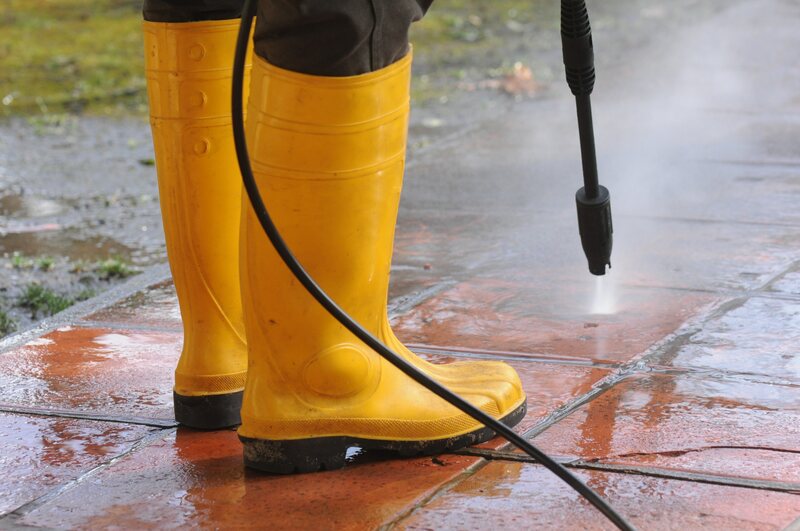Are you looking to tackle tough outdoor cleaning tasks with ease? A pressure washer might be just the tool you need. So actually, how does a pressure washer work?
In this article, we will explore what a pressure washer is, how it works, its different components, types, and uses.
We will also discuss important safety precautions to keep in mind while using a pressure washer and share some handy tips for optimal performance.
If you want to make outdoor cleaning a breeze, keep reading to learn more!
What Is a Pressure Washer?
Before going further into the discussion about how does a pressure washer work, of course you must first understand what it is.
A pressure washer is a powerful tool that uses high-pressure water spray to remove dirt, grime, mould, dust, and other substances from surfaces. It is commonly used for cleaning outdoor areas such as driveways, decks, pavements, and vehicles.
Pressure washers work by forcing water through a narrow nozzle at high speeds, creating a focused and powerful stream that can easily dislodge tough stains and debris. The adjustable pressure settings make them versatile for various surfaces, from delicate wood to tough concrete.
One of the key benefits of pressure washers is their ability to save time and effort compared to traditional cleaning methods. By utilising the strength of water pressure, they provide efficient and thorough cleaning results in a fraction of the time.
Common applications of pressure washers extend beyond residential use to commercial and industrial settings. They are often employed for tasks such as graffiti removal, paint stripping, and preparing surfaces for painting or sealing.
How Does a Pressure Washer Work?
Next, let’s get into the core discussion, which is how a pressure washer works.
A pressure washer works by drawing in water from a hose and then pressurizing it using a pump. The high-pressure water is then sprayed through a nozzle to create a powerful jet that can effectively clean various surfaces.
The pump in a pressure washer is a crucial component responsible for pressurising the water. It typically operates using either an axial or triplex piston pump, both of which generate the necessary pressure for cleaning tasks.
The nozzle, on the other hand, plays a vital role in controlling the flow and direction of the high-pressure spray. By adjusting the nozzle settings, users can fine-tune the water jet for different cleaning requirements.
The motor powers the pump to maintain the consistent high pressure needed for efficient cleaning operations.
a. The Components of a Pressure Washer
The main components of a pressure washer include an electric or gas-powered engine, a high-pressure pump, hoses, nozzles, and spray tips. These components work together to generate the necessary power and pressure for effective cleaning.
The engine, whether electric or gas-powered, is the heart of the pressure washer. It provides the energy needed to drive the pump and create the high-pressure water flow. The high-pressure pump plays a crucial role in pressurizing the water to the desired level. Hoses act as conduits, transporting the pressurized water from the pump to the nozzle. Nozzles and spray tips are the final components that control the spray pattern and intensity, allowing for precise cleaning.
b. The Function of Each Component
The engine or motor provides the power to drive the pump, which pressurises the water. The hoses deliver the pressurised water to the spray gun, where the nozzle and tip control the spray pattern and intensity for efficient cleaning.
In the cleaning process, the engine or motor plays a vital role in generating the necessary power required to drive the pump, which, in turn, pressurises the water for effective dirt removal. The hoses act as conduits that transport the pressurised water from the pump to the spray gun.
Once the pressurised water reaches the spray gun, the nozzle and tip become crucial components that determine the spray pattern and intensity of the water jet. By adjusting the nozzle and tip, users can customise the cleaning experience to suit different surfaces and levels of dirt accumulation.
See product: Pressure Washer Karcher K5 Premium Smart Control Home
The Different Types of Pressure Washers
Pressure washers come in various types, including electric, gas-powered, and diesel models. Each type has its advantages and is suitable for different cleaning tasks.
Electric pressure washers are popular for their lightweight design and ease of use, making them ideal for smaller cleaning projects around the house or garden. They are generally quieter and more environmentally friendly than gas-powered models, emitting no exhaust fumes.
On the other hand, gas-powered pressure washers are known for their higher cleaning power, making them perfect for tackling tough, large-scale cleaning tasks such as driveways, sidewalks, and decks. They provide greater mobility due to not being restricted by cords, but they tend to be heavier and require more maintenance.
a. Electric Pressure Washers
Electric pressure washers are ideal for light to medium-duty cleaning tasks around the house. They are easy to use, eco-friendly, and require less maintenance compared to gas-powered models.
One of the standout features of electric pressure washers is their convenience. These machines are lightweight and compact, making them easy to move around and store. They are much quieter than gas-powered washers, reducing noise pollution in your neighbourhood. In terms of power efficiency, electric models provide consistent pressure for effective cleaning without wasting excess water. Their eco-friendly nature means they produce zero emissions, contributing to a cleaner environment. Whether you need to clean your patio, car, or outdoor furniture, an electric pressure washer is a versatile and efficient tool for all your home cleaning needs.
b. Gas Pressure Washers
Petrol pressure washers are more powerful than electric models, making them suitable for heavy-duty cleaning tasks such as removing tough stains, paint, and mould. They offer greater mobility but require more maintenance.
One of the key advantages of petrol pressure washers is their exceptional cleaning power, which is essential for tackling stubborn dirt and grime.
Petrol pressure washers are highly versatile, able to adjust their water pressure to suit different surfaces, from delicate car exteriors to durable concrete driveways.
The mobility of these washers is invaluable for reaching distant or outdoor areas without being tethered to a power outlet.
c. Diesel Pressure Washers
Diesel pressure washers are industrial-grade machines designed for heavy-duty cleaning in commercial settings. They offer high power and efficiency, making them ideal for large-scale cleaning projects.
These robust machines are equipped with sturdy diesel engines that provide superior performance and reliability, ensuring consistent operation even in challenging environments. The high pressure generated by diesel pressure washers allows for the effective removal of tough grime, grease, and dirt, reducing cleaning time significantly.
Plus their power, diesel pressure washers are known for their fuel efficiency, making them cost-effective options for businesses with extensive cleaning needs. Their durability and long lifespan contribute to cost savings in the long run, offering excellent value for money.
The Uses of a Pressure Washer
Pressure washers are versatile tools that can be used for various purposes, including cleaning outdoor surfaces, removing tough stains and grime, and preparing surfaces for painting or refinishing.
These powerful machines are highly effective in cleaning driveways, decks, patios, and pavements, providing a quick and efficient way to spruce up outdoor areas. They excel in removing stubborn dirt, mildew, and mould, making them ideal for deep cleaning tasks that are hard to tackle with traditional cleaning methods.
Moreover, pressure washers are also invaluable for prepping surfaces before painting or refinishing. By removing old paint, grime, and debris, they ensure a smooth and clean base, promoting better adhesion and longevity of the new finish.
a. Cleaning Outdoor Surfaces
Pressure washers are particularly effective for cleaning outdoor surfaces such as driveways, patios, decks, and fences. The high-pressure water spray can quickly remove dirt, moss, and grime from these areas.
One of the key advantages of using pressure washers is their ability to tackle tough stains and residues that regular cleaning methods might struggle to address. The intense force behind the water stream allows for deep cleaning, reaching into crevices and pores to lift embedded dirt particles.
The versatility of pressure washers enables them to handle various surfaces with ease, from concrete and wood to metal and stone. This adaptability makes them a valuable tool for maintaining the cleanliness and visual appeal of outdoor spaces.
b. Removing Stains and Grime
Pressure washers excel in removing tough stains, grease, oil, and grime from surfaces such as concrete, brick, and cladding. The high-pressure spray can penetrate deep to clean and restore the surface.
With their powerful jets of water, pressure washers are highly effective in dislodging even the most stubborn residues that have become ingrained over time.
The force of the spray is adept at reaching into nooks and crannies, ensuring a thorough clean that traditional cleaning methods often can’t achieve.
Whether it’s unsightly mould patches on your deck or years of grime build-up on your driveway, a pressure washer can revitalise these surfaces, leaving them looking fresh and renewed.
The versatility of pressure washers allows you to adjust the pressure settings based on the surface being cleaned, ensuring optimal results without causing damage.
Investing in a pressure washer is not just about cleaning; it’s about transforming surfaces and bringing back their original lustre.
c. Preparing Surfaces for Painting
Before painting or refinishing surfaces, using a pressure washer to clean and prepare the area can ensure better adhesion and longevity of the paint. It removes dirt, peeling paint, and other contaminants effectively.
The use of a pressure washer in surface preparation for painting projects is crucial for achieving a smooth and attractive finish. Not only does it eliminate layers of dirt and grime, but it also strips away old paint that may hinder the new coat from adhering properly.
By power washing the surface, you create an ideal canvas for the fresh paint to bond with, ensuring a durable and long-lasting finish. The high-pressure water stream reaches into crevices and textures, providing a thorough clean that cannot be achieved through manual scrubbing alone.
The Safety Precautions When Using a Pressure Washer
When using a pressure washer, it’s essential to follow safety precautions to prevent injuries and accidents. Wearing protective gear, using the correct nozzle and pressure settings, and keeping children and pets away are crucial safety measures.
Protective gear such as goggles, gloves, and sturdy footwear shields you from potential debris and chemicals that could cause harm.
Ensuring the machine’s settings are appropriate for the task at hand, and adjusting both pressure and nozzle accordingly helps avoid excessive force or damage.
Creating a clear work area free from clutter and obstacles reduces the risk of tripping or falling while operating the pressure washer.
Prioritising safety not only safeguards you but also enhances the efficiency and longevity of your equipment.
a. Wear Protective Gear
Protective gear such as goggles, gloves, and closed-toe shoes should be worn when using a pressure washer to prevent injuries from water spray, debris, or chemical exposure. Safety should always be a top priority.
Ensuring proper protection while operating a pressure washer is crucial in safeguarding yourself against potential risks. Goggles shield your eyes from high-pressure water and debris that may be propelled during cleaning. Gloves not only protect your hands from harsh cleaning chemicals but also provide a better grip on the equipment, reducing the chances of accidental slips. Closed-toe shoes offer protection from falling objects and slippery surfaces, ensuring stability and preventing foot injuries.
By wearing the necessary safety equipment, you create a barrier between yourself and potential hazards, minimising the likelihood of accidents. Personal protective equipment (PPE) acts as a shield that can significantly reduce the impact of unforeseen incidents. It is important to choose PPE that fits well, is in good condition, and meets safety standards to maximise its effectiveness in safeguarding your well-being during pressure washing tasks.
b. Use the Correct Nozzle and Pressure Setting
Using the correct nozzle and pressure setting is crucial for safe and effective pressure washing. Different nozzles and pressure levels are suitable for specific cleaning tasks and surfaces.
For instance, when tackling delicate surfaces like wood or painted areas, opting for a low-pressure nozzle combined with a wider spray angle can prevent damage caused by excessive force. On the other hand, stubborn stains on concrete or metal may require a high-pressure nozzle with a more concentrated stream for effective removal.
Adjusting the pressure setting appropriately can not only enhance cleaning efficiency but also ensure safety. A pressure gauge can help in regulating the force applied, reducing the risk of damage or injury. It’s essential to refer to the manufacturer’s guidelines and test different settings to find the ideal combination for each cleaning project.
c. Keep Children and Pets Away
To ensure a safe working environment, it’s important to keep children and pets at a safe distance when using a pressure washer. The high-pressure water spray can cause harm if not handled properly.
Maintaining a safe distance is crucial as the force of the water jet can lead to serious injuries if it comes into contact with the skin. One must also be cautious about potential hazards and risks associated with using a pressure washer around little ones or furry companions.
Creating a clear barrier and ensuring they are kept at a safe distance, reduces the chances of accidents occurring, providing a level of safety for everyone involved during the cleaning process.
d. Use Caution on Delicate Surfaces
When cleaning delicate surfaces such as wood, paint, or glass, exercise caution with the pressure washer. Adjust the nozzle to a wider spray pattern and lower pressure to avoid damage.
For wood surfaces, it’s essential to use a nozzle with a broader fan pattern to distribute the pressure evenly and protect the material. Keep the pressure at a moderate level to prevent gouging or stripping the wood grains.
When dealing with painted surfaces, opt for a low-pressure setting to avoid peeling or chipping. Adjust the nozzle angle to a gentler position to prevent forcing water under the paint layers.
Glass surfaces require special care; use a nozzle with a softer touch and reduce the pressure considerably to prevent cracks or scratches. It’s advisable to start from a distance and gradually approach the surface while maintaining safe pressure.
Tips for Using a Pressure Washer Properly
To ensure optimal performance and safety when using a pressure washer, follow these essential tips: test on a small area first, use the right cleaning solution, work in sections, and rinse thoroughly after cleaning.
Before starting, make sure to carefully read the manufacturer’s instructions for your specific pressure washer model to avoid any mishaps. When selecting a cleaning solution, opt for the ones recommended for pressure washers to prevent damage to the machine. Begin cleaning by starting at the top of the surface and moving downwards to ensure even coverage and avoid streaks. Once you have finished cleaning a section, always remember to thoroughly rinse it to remove all residue and prevent streaking or spotting.
a. Test on a Small Area First
Before starting a cleaning job, always test the pressure washer on a small, inconspicuous area to ensure it does not damage the surface. This helps determine the right pressure and nozzle setting.
By conducting a preliminary test, you can assess the compatibility of the pressure washer with the specific surface material. Different surfaces react differently to pressure, so this step is crucial for protecting your property from any potential harm.
Pre-testing facilitates evaluating the cleaning efficiency of the machine. It allows you to observe how effectively the pressure washer removes dirt and grime without causing any undesirable effects.
Ultimately, pre-testing ensures optimal results by fine-tuning the settings before tackling the entire cleaning task, saving you time and potential rework.
b. Use the Right Cleaning Solution
Choosing the correct cleaning solution for the task at hand is crucial for maximising the cleaning power of the pressure washer. Select solutions that are compatible with the surface and the cleaning requirements.
When choosing a cleaning solution for your pressure washer, it’s essential to consider the type of surface you are cleaning as well as the nature of the dirt or grime that needs to be removed. Different surfaces may require different solutions to avoid damage while effectively cleaning. For example, selecting a gentle eco-friendly formula for delicate surfaces like wood or painted walls can prevent any potential harm. On the other hand, for tougher tasks like removing oil stains from concrete, opting for a degreaser or a specialised cleaner can ensure thorough cleaning.
c. Work in Sections
When cleaning large surfaces, such as driveways or decks, it’s advisable to work in sections to ensure thorough cleaning and consistent results. Divide the area into manageable parts for better efficiency.
Breaking down the surface into smaller sections allows you to focus on one area at a time, ensuring that no spots are missed and that each part receives the necessary attention. By dividing your cleaning tasks this way, you can also prevent overwhelming yourself with a daunting, massive job, making the process feel more achievable and less tiring. Working in sections promotes a systematic approach, enabling you to track your progress and maintain a structured cleaning routine for optimal results.
d. Rinse Thoroughly
After cleaning with a pressure washer, ensure to rinse the surface thoroughly with clean water to remove any remaining detergent, dirt, or debris. Proper rinsing enhances the final cleaning results.
Thorough rinsing plays a crucial role in ensuring the effectiveness of the cleaning process. By rinsing off the surface, you are not only getting rid of the visible particles but also eliminating any residual cleaning agents that may interfere with the surface integrity. Rinsing serves as the final step in achieving a pristine finish, allowing the surface to dry naturally without any unwanted residues. Remember, a thorough rinse is the key to achieving a clean and spotless surface after pressure washing.
Now you already know how does a pressure washer work. In order for it to function optimally and last long, make sure to choose a quality pressure washer, such as cleaning products from TEKA Cleaning.
TEKA Cleaning provides a wide range of professional cleaning products, including pressure washers, with high quality standards that you can use for various needs.
In addition to pressure washers, you can also get other high-quality cleaning products, such as dry vacuum cleaners, scrubber driers, spray extraction, and so on.
So, whether you’re tackling a tough cleaning project at home or require reliable tools for commercial cleaning tasks, TEKA Cleaning has the equipment you need to get the job done right. Our selection of high-quality cleaning products, from pressure washers to dry vacuum cleaners and beyond, ensures that you can find the perfect tool for every cleaning challenge.
Why settle for less when you can have the best? TEKA Cleaning’s commitment to excellence means we only stock products from the most trusted brands in the industry, ensuring durability, efficiency, and effectiveness. Our expert team is always on hand to provide guidance and advice, helping you select the right products for your specific needs.
Embrace the power of professional-grade cleaning equipment and make your cleaning tasks easier and more effective. Visit TEKA Cleaning today to explore our extensive range of products. Whether you’re in the market for a pressure washer to tackle outdoor cleaning or need a specialized tool for a specific job, we’ve got you covered.
Don’t miss out on the opportunity to elevate your cleaning game with TEKA Cleaning products. Contact us now or visit our website to browse our selection and find out more about how our products can benefit you.
For enquiries or to make a purchase, give us a call on 01233 751 544. Let TEKA Cleaning be your go-to source for all your cleaning needs, ensuring you always have the right tools for the job.
Read also:










